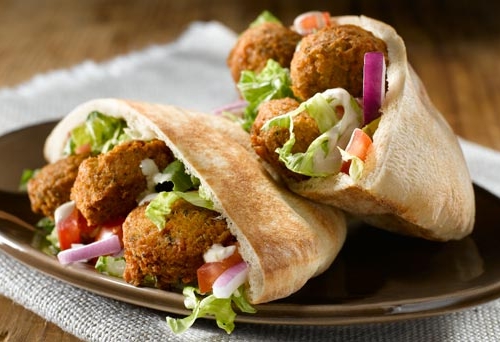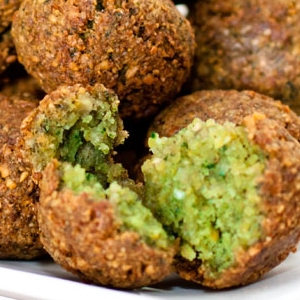Folks are becoming more aware of the plant-based protein universe. It’s the coming thing, as meat becomes more and more unsustainable in our changing world. Today, let’s explore the challenge of updating a Middle Eastern veggie classic…
 Classic falafel pita pockets: They’ll be even tastier and
Classic falafel pita pockets: They’ll be even tastier and
easier to make when you use Quinoafels!
It’s already a staple across the Middle East, and comes in many formats. But the basic premise re-mains the same ‘across platforms’: The Falafel is a ball of savoury ground chick peas deep-fried to a rich golden brown…
A ‘native guide’
When I was in radio news, I worked with a guy who had his own Middle Eastern restaurant on the side. His on-air name was Al, but at home they called him Ali.
Al bankrolled the cozy little hole-in-the-wall joint on Somerset St., in the near west end of the city. Every second three-story red-brick walk-up had an artsy boutique, a professional office or an eatery on the ground floor. Members of his family ran the resto, and he stepped in as Maître D’ on weekends. Totally looked the part, too, with his classic pencil-thin mustache, in his dinner jacket…
My pal, Al
Al was not just a restaurateur. He was a great believer in his family’s rich, ancient culture. And he took any opportunity that came up to expound upon the merits of Lebanese food. He didn’t just recom-mend restaurants; he’d drag you out to any you showed the slightest interest in. That’s how I was introduced to Middle Eastern food.
Al’s own resto was an up-scale place. But I quickly learned we had two ‘family style’ Lebanese eater-ies within walking distance of the radio station.
Kamal’s: The real deal
Kamal’s on Bank St., Al insisted, was about as authentic a shawarma joint as one could wish for. Back then, there were no shawarma walk-up counters like there are today. Kamal’s was a cozy sit-down-or-take-out place, family run, and open noon until midnight. Convenient for Al and me when we worked the 4-11 shift.
One of the first lessons he taught me about his culture’s cuisine was, you can’t improve on perfect-ion. And Kamal’s falafels were as close to perfect as any you could find in Ottawa. (Except, of course, for his Mom’s, as served at his resto.)
Improve on perfection?
Al considered the falafel the epitome of Middle Eastern cuisine. So simple, yet so complex and delicate, in flavour and texture – provided you got it just right. And you couldn’t improve on the perfect falafel. Period. Full stop.
Sorry, Al! I disagree…
And I have come up with what I consider the perfect hack, to both elevate the falafel and usher it into the coming era, where plant protein will be king.
Behold: The Quinoafel!
This approach has a number of definite advantages:
Nutrition
Quinoa is one of a few foods that provides a complete nutritional protein complex in one package. To obtain a proper balance of nutrients, vegetarians and vegans have traditionally adhered to the classic beans-and-rice combo. In India and surrounding cultures, they often default to rice and lentils. There are other tried-and-true such pairings – all consisting of a grain and a legume. Why not cut to the chase and use quinoa?
Flavour
Unlike chick peas – which have a relatively mild, innocuous flavour – quinoa has a distinct though delicate nutty flavour. It’s a great complement to the herbs and garlic in the classic falafel recipe.
Texture
Grinding the chick peas to just the right consistency can be a royal pain. Just ask anyone who’s made falafel – or, for that matter, hummus – from scratch. I’ve found it’s ideal to cook the quinoa as you normally would, and just leave it as is, in uniform tiny granules. They’ll stick together nicely when blended with the other ingredients, forming tight but not-to-dense balls.
My take
The only real departure you might want to make from the classic falafel recipe is to coat the exterior of each ball with some chick pea flour or potato starch. That will help produce an authentic fine-textured, crispy crust. Your Quinoafels will have a darker interior than the traditional version, shown in the photo, top of page.
Overall, my Quinoafel hack is faster and easier to make, and tastier than the traditional version. And delivers a complete dietary protein. That’s important, especially when you plan to use it as a main dish or as the principle filling in a sandwich or pita pocket.
The Quinoafel also lends itself to pan frying or grilling. Versions of the classic are found, variously, in the form of balls, flattened patties and cigar-shaped rolls across its home range.
I hope you’ll try the Quinoafel. I think it has real potential!
~ Maggie J.

